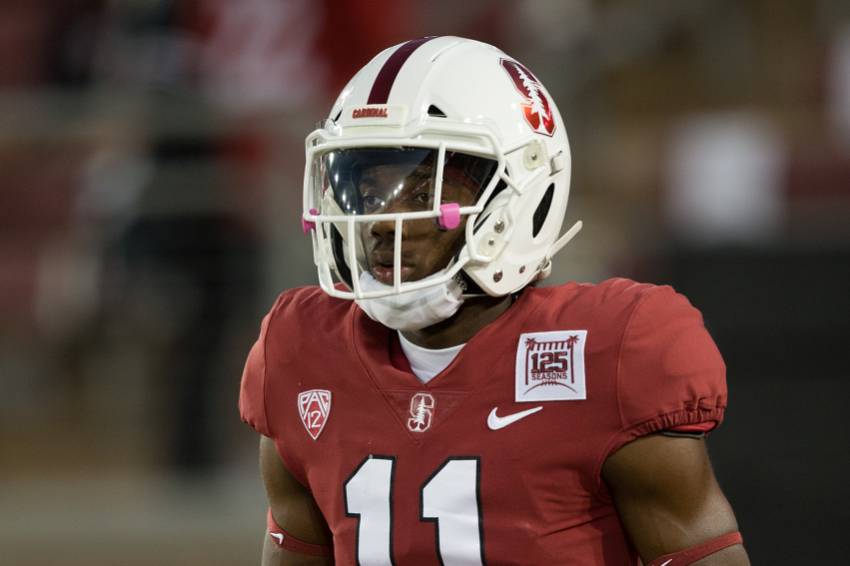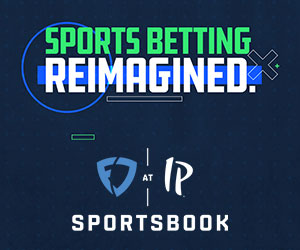Saints trade up in third round, pick Stanford cornerback Paulson Adebo

In their typical aggressive fashion, the Saints executed a trade Friday night to move up in the third round of the NFL Draft.
New Orleans sent their two third round picks (98th and 105th overall) to move up to the 76th spot to draft Stanford cornerback Paulson Adebo.
The 6-foot, 198 pounder opted out of the 2020 season after posting two highly productive years in college. Adebo had 38 pass breakups and eight interceptions in 22 career games.
The Athletic
SUMMARY: A two-year starter at Stanford, Adebo was the left cornerback in defensive coordinator Lance Anderson’s scheme, lining up primarily outside in both man and zone. He put himself on the NFL radar with an All-American redshirt freshman season, but his sophomore year fell short of expectations and he chose not to play in 2020, creating a challenging evaluation for NFL teams. Adebo stays attached to routes once he is connected, displaying the length and ball-tracking ability to consistently disrupt the catch point (34 passes defended, eight interceptions in 22 games). While he competes with confidence and toughness, negative plays usually result from inconsistent discipline and body fundamentals. Overall, Adebo is a leggy, upright athlete prone to false steps, but his size, foot agility and instinctive ball skills are traits worth gambling on. He projects best as a press-man corner who can also play in a Cover 3 scheme.
NFL.com
Overview: High-cut, verified ballhawk with a long, angular frame that is challenging to navigate in cramped quarters. Adebo’s size and ball skills give him a distinct advantage when the ball is in the air and he attacks throws with a receiver’s mindset. He plays upright and lacks desired fluidity to shadow sharp route breaks and double moves. However, his ability to recover and make it home to the catch point could excite GMs and secondary coaches. His 2019 tape was a bit disappointing compared to 2018 and he opted out of the 2020 campaign. He still has football and technique to learn — versus the run and pass — and teams might have to live with the same ups and downs that were evident on his 2019 tape. He’s more playmaker than lockdown corner, but can range in Cover 3 or play physical in press-man.
Paulson Adebo is a CB prospect in the 2021 draft class. He scored a 9.58 RAS out of a possible 10.00. This ranked 74 out of 1744 CB from 1987 to 2021.
No significantly change for Stanford's times, so Paulson Adebo keeps a really good score.https://t.co/Xu37841d5G #RAS pic.twitter.com/BYxqrBJFwd
— Kent Lee Platte (@MathBomb) March 22, 2021
Adebo led the PAC-12 in interceptions in 2018 and earned first-team all-conference honors in 2019.
Entering the draft, the Saints lack any proven depth at boundary cornerback outside of Marshon Lattimore so Adebo has a chance to compete as a rookie for immediate snaps.
New Orleans Saints Cornerback Paulson Adebo
Video Call with New Orleans Media
Friday, April 30, 2021
How much contact did you have with the Saints and what skills do you have that you feel will be transferable from college to the NFL?
“Yeah, so talking to the Saints, I think I spoke to the DB coach, I spoke to the scouts, but nothing that was any more or less than any of the other teams I was speaking with. So honestly (I) didn’t really know if they were super duper interested in me or anything like that. But as far as the things I think I can bring to the league, I think I’m a playmaker. If you look at my career, eight interceptions in 22 games, somebody who was extremely productive on (the) ball. And I think that’s something I could bring to the league and help make takeaways.”
What’s your favorite coverage to play in?
“Right up, man, whenever I’m just locking up my dude, one on one, don’t let the guy in front of you catch the ball. But obviously played at Stanford. We played a lot of different coverages. So I feel comfortable doing (anything) whether I’m playing and, zone, three technique or if I’m playing true squat technique, I feel like we played a lot of different things, man under so I feel really well versed.”
How would you describe yourself as a person and as a player to someone who is just learning about you?
“So myself as a person, someone who’s very, very driven in everything I do. Myself as a player, same way, someone who’s driven, someone who’s going to come in every day and be one of those guys that’s the last person off the field and really just put everything out onto the field.”
Do you feel like you can be like a lockdown cornerback in the NFL? Do you feel like maybe you should have went a little bit higher in this draft?
“Honestly, I’m happy that I came to the Saints, right. One of my mottos is everything that happens had to happen. So (it is) not exactly where you go or how high you get pick. But the fact that I’m here, I’m happy to be here. So not really here to dwell on anything. Obviously, I set out the season so that probably had something to do with it. If you’d look at my production, passes defended, interceptions, any stat that’s a makeup of a good cornerback and you can tell that I’m going to have the opportunity to be a lockdown corner.”
Have you researched the saints? Do you know about the situation here and there (being) a perceived need for a cornerback and also did you hear your coach talk about Sean Payton and the Saints given the fact that, you know David Shaw and Sean Payton did coach together 20 plus years ago in Philadelphia?
“Not too much. Kind of don’t really know too much about the organization. But happy to be here and happy to learn as I go.”
You kind of mentioned it a little bit, how much you feel like the opt out kind of did affect your draft stock negatively? Was that something you maybe anticipated going into this year? And if you could provide a little context, just what all went into opting out. I know it’s been a crazy year for everybody.
“Right. Obviously, you opt out, that’s going to have something to do with how teams are evaluating you. Obviously, they haven’t seen me play in over a year. So I’m sure that has something to do with it. For me, the decision to opt out just came with a lot of uncertainty, especially with the Pac-12, one of the last conferences to really get on board with even playing the season. So prior to the season, talking to everybody, and again, I always say it’s not a time to point the finger at anybody in any direction to say, Oh, we should have got more information because at the same time, nobody knew what was going on. So (it was a) completely nuanced situation. But for me personally, just too much uncertainty surrounding how many games you’d have to miss. If you test positive, would you have to miss two games, one game? Could you practice that week? So all those kinds of different factors led me to say, you know what, I’m going to opt out train and move to the next step.”
I know some guys that opted out then they opted back in. I mean, did that cross your mind at all? Did you debate that?
“Not at all. I think that was one of those decisions I made and it was a tough decision. And once I made it, I just kind of went full tilt. So I decided where I needed to go train, decided what agent I was going to have and then kind of never looked back.”
The statistical numbers you put up your last two years of football at Stanford are pretty crazy. What would you kind of attribute that to? How do you kind of approach the ball when it’s in the air?
“Yeah, some of that some of that has to do with the fact that I played receiver growing up, so I’m comfortable with the ball in the air. But just a lot of work I put in. My freshman year, I redshirted, didn’t play and that year kind of gave me a lot of time to work on a lot of the finer details. Obviously, coming from high school, I’m playing corner, but I’m not really learning the position. So once I got to college learning under Coach (Duane) Akina, who I think is probably the best DB coach to do it at the collegiate level. That’s all of those things that kind of helped me to be able to excel on the field.”
One of the things that the scouting reports always seem to mention about you is your high football IQ. Is that just natural? Is it a lot of film study? Or is it a little bit of both?
“Honestly, I have to credit my coach for that, Coach (Duan) Akina. The way he taught us the game, not only knowing what you’re doing, but knowing what the nickel’s doing, knowing what the safety’s doing, knowing what the backers are doing, and that being able to help you play faster. So (I) definitely credit that to my coach, school and teammates.”
You’re from the Dallas area, right? How did you wind up and why did you wind up at Stanford? What went into that?
“Yeah, obviously, Stanford’s a great school, one of those schools that when they do offer you, you really have to take a hard look at it, regardless of if you were looking at them beforehand. But for me, when I was going through my recruiting cycle, Christian McCaffrey was there, Solomon Thomas was there. They were competing for Pac-12 championships, Rose Bowl championships. So before I even really knew about the brand of Stanford and what that can do for you, just looking at an exciting team and me being competitive knowing that I can go there and still compete at a high level. That was intriguing for me.”
- < PREV Saints draft Ohio State linebacker Pete Werner with second round pick
- NEXT > REPLAY: Brother Martin routs Scotlandville to advance to state baseball quarterfinals




